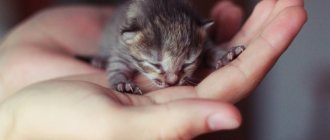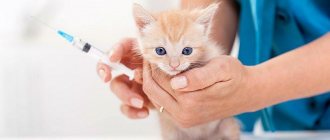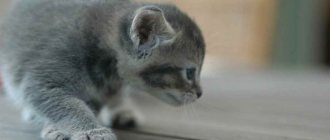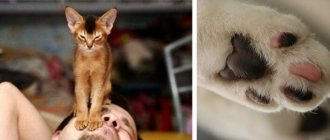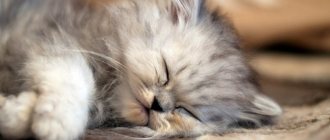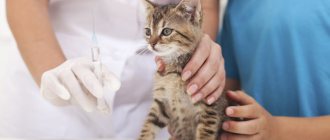Immediately after birth
Mother cats tend to look for cozy and quiet places to give birth. But if desired, the owner can create it for her pet. For example, you could line a box with towels and place it all in a quiet, dark room.
After the birth of children, if the cat is unable to do anything, the owner needs to:
- remove amniotic sacs (water membranes) from around their faces and bodies;
- Wipe the mouth and nose with a soft cloth and make sure that the kitten begins to scream or breathe;
- get rid of the remnants of the membrane from the body of newborn kittens;
- cut the umbilical cord. To do this you need a clamp and clean scissors. The distance for cutting is 2 cm from the abdomen.
How cats take care of kittens
Pregnancy in cats lasts 63–65 days, and by the time of birth, the expectant mother is looking for a suitable place for a “nest.” And when all the kittens are born, they begin to master the feeding process: each finds a nipple and receives a portion of “first milk” (colostrum). At this time, it is important that the cat eats well - in this case, there is a chance that there will be enough milk.
In the first three to four weeks after the birth of kittens, cats usually behave as extremely caring mothers. They rush to every squeak of the cub and “bend every way” to satisfy all the needs of the babies.
It is advisable for kittens to stay with the cat for at least eight weeks before going to their new homes.
Source
First few weeks
The first time after birth, kittens see and hear poorly, so they have to live by their instincts. They smell milk and reach out to their mother to feed on it.
If more kittens were born than the mother has nipples, then the owner needs to swap some of the cubs herself so that everyone can taste the mother’s milk.
As for grooming, mom licks the belly and anus, making them want to go small and big. If the kittens do not have a mother, then the person should take care of this issue on their own by stroking those places with a warm and damp washcloth.
First month
When the kittens are 14 days old and begin to move independently, the cat begins to teach them all the habits.:
- Lick yourself. Kittens, looking at their mother, also repeat licking and washing.
- Teaches you to relieve yourself in a specially designated place (tray). Over time, the kitten will go to this place on its own.
- A cat raises her kittens. She tells them what to do and what not to do. At this age, kids love to frolic and fool around. The mother cat keeps this fun process under control, and in case of excessive fun or biting, she can calm the kitten down with her paw.
To properly care for kittens, the cat must be provided with a safe and warm place. This can be a box or a special bed with a clean diaper, which can be covered on top if necessary. In the first days, it is better not to interfere with the cat's care for newborns.
When a mother cat takes care of a kitten, it is very touching. She feeds him, helps him get on his paws, teaches him hunting instincts and cleanliness. Without her care and attention, small creatures may not survive. In such cases, the owner must come to the rescue and take on all the troubles of caring for newborns.
Source
First movements
About three weeks after birth, it is time for socialization, when the offspring begins to independently explore the environment. This is when the mother begins to encourage curiosity. However, she still worries, so you can hear a rather strange sound from her when she calls out to those who have wandered too far.
By four weeks, kittens should be fairly stable on their feet. Then their mother begins to wean them off milk. By six weeks they will begin to play, jump and climb.
Many experts recommend exposing kittens to people between four and six weeks. You need to pet them gently and calmly enough so that they get used to your touch.
How does a cat raise her kittens?
From the first day, a cat that has become a mother develops the maternal instinct to care for its offspring, which is inherent in nature.
In the cat family it is very pronounced. How a cat cares for kittens will be discussed in this article. When kittens appear in the house, the owners have great responsibility and worries not only for the cat, but also for her babies. Although the mother cat takes care of her offspring herself, the owner needs to help her properly, especially when the cats stand on their paws and start running away from her. But on the other hand, in the first days after birth, caring for kittens can be harmful. At first, it is advisable not to interfere with this process, since the mother cat may refuse to care for and feed the kittens. There are also cases when a careless mother can simply reject the babies.
It is the owner’s responsibility to provide the cat with food and water in sufficient quantities, and to change diapers under it as needed. In addition, it is important to monitor the health of the mother in labor. Alarming symptoms, the appearance of which is a reason to contact a veterinarian: fever, purulent discharge, excessive swelling of the nipples.
Maternal aggression
Don't worry if your cute kitty turns into a snarling tigress after giving birth. This is completely normal behavior, since the reason for this is increased hormonal levels.
If you try to interact with a pet or its litter, you may encounter an unpleasant hiss.
The animals need to be in a protected environment so that the mother cat can do her job of raising the kittens without struggling with feelings of aggression.
Does a cat need to give birth?
If a cat lives in your house and you are not going to breed these animals (and for this you need to have a huge amount of knowledge, skills and abilities, so it is better to leave breeding to specialists), it is worth sterilizing it in order to prevent the appearance of unplanned offspring, which will then have an extremely difficult time will find “good hands”.
Unfortunately, two harmful myths are still extremely persistent among cat lovers and owners:
- Every cat needs to give birth at least once in its life “for its health.”
- Neutered cats are prone to obesity.
This has nothing to do with reality.
In the photo: kittens. Photo: goodfreephotos.com
First month
When the kittens are 14 days old and begin to move independently, the cat begins to teach them all the habits.:
- Lick yourself. Kittens, looking at their mother, also repeat licking and washing.
- Teaches you to relieve yourself in a specially designated place (tray). Over time, the kitten will go to this place on its own.
- A cat raises her kittens. She tells them what to do and what not to do. At this age, kids love to frolic and fool around. The mother cat keeps this fun process under control, and in case of excessive fun or biting, she can calm the kitten down with her paw.
To properly care for kittens, the cat must be provided with a safe and warm place. This can be a box or a special bed with a clean diaper, which can be covered on top if necessary. In the first days, it is better not to interfere with the cat's care for newborns.
When a mother cat takes care of a kitten, it is very touching. She feeds him, helps him get on his paws, teaches him hunting instincts and cleanliness. Without her care and attention, small creatures may not survive. In such cases, the owner must come to the rescue and take on all the troubles of caring for newborns.
How does a cat care for kittens?
From the first day, a cat that has become a mother develops the maternal instinct to care for its offspring, which is inherent in nature. In the cat family it is very pronounced. How a cat cares for kittens will be discussed in this article.
When kittens appear in the house, the owners have great responsibility and worries not only for the cat, but also for her babies. Although the mother cat takes care of her offspring herself, the owner needs to help her properly, especially when the cats stand on their paws and start running away from her. But on the other hand, in the first days after birth, caring for kittens can be harmful. At first, it is advisable not to interfere with this process, since the mother cat may refuse to care for and feed the kittens. There are also cases when a careless mother can simply reject the babies.
© shutterstock
It is the owner’s responsibility to provide the cat with food and water in sufficient quantities, and to change diapers under it as needed. In addition, it is important to monitor the health of the mother in labor. Alarming symptoms, the appearance of which is a reason to contact a veterinarian: fever, purulent discharge, excessive swelling of the nipples.
How does a cat care for its offspring?
Since ancient times, cats have lived next to humans.
These are friendly and welcoming animals that not only brighten up people’s leisure time, but also help rural residents rid their homes of unwanted guests: mice and rats. Cats extend their kindness and caringness not only to humans, but also to their offspring. The ability to give birth in cats appears quite early and persists until old age. In the wild, cats typically breed once a year. But in a comfortable home environment, kittens can be born two or even three times a year.
Just before the babies are born, the cat begins to look for a secluded, quiet and safe place. In the wild, this could be a hollow, someone's abandoned hole, or just an inconspicuous place. At home, the cat's owners should take care of such a place, otherwise it can settle anywhere, for example, in a closet, on a shelf with clothes. Because of this feature in the behavior of cats, they are classified as nesting animals.
In one litter, a cat has from three to eight kittens. Immediately after the babies are born, the mother cat licks them thoroughly. Kittens are born very helpless, they do not yet see or hear, but only squeak pitifully and crawl on their stomachs. But newborns distinguish smells very well and use this ability to navigate in a world unfamiliar to them. Often a kitten crawls too far from its mother, and then she takes such a kitten by the scruff of the neck with her teeth and returns it back to the nest.
The babies feed on mother cat's milk. They develop quite quickly. Within a week or a week and a half, the cat cubs’ eyes begin to open, and a few days after this, the kittens can distinguish surrounding objects. Two weeks after birth, babies are able to respond to external sounds.
While the kittens are small and helpless, they are protected by the mother cat. During this period, cats may show aggression if they believe that their offspring are in danger. They fiercely protect their home and babies from other animals, and can also show aggression towards humans during this period.
